For this question, refer to the TerramEarth case study.
TerramEarth's CTO wants to use the raw data from connected vehicles to help identify approximately when a vehicle in the development team to focus their failure. You want to allow analysts to centrally query the vehicle data. Which architecture should you recommend?
A)
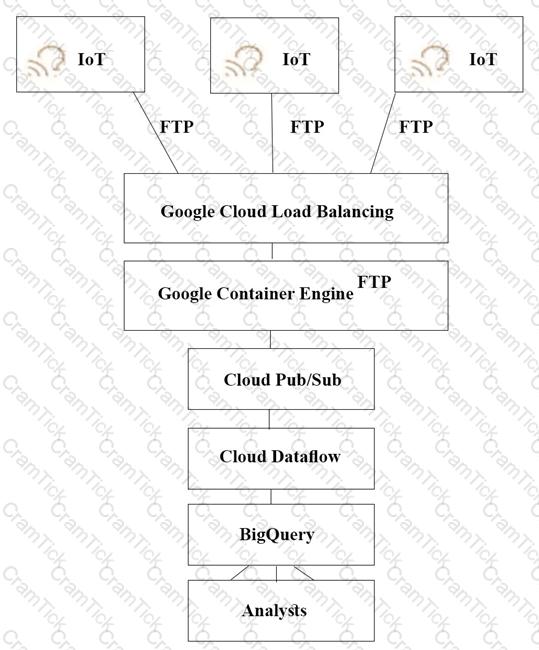
B)
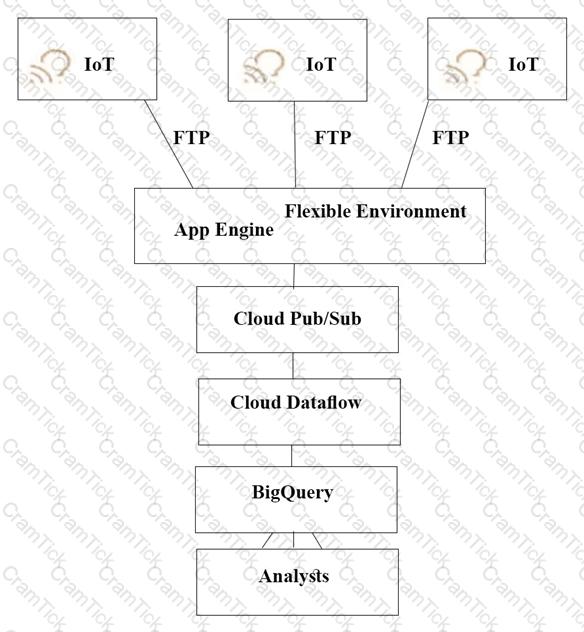
C)
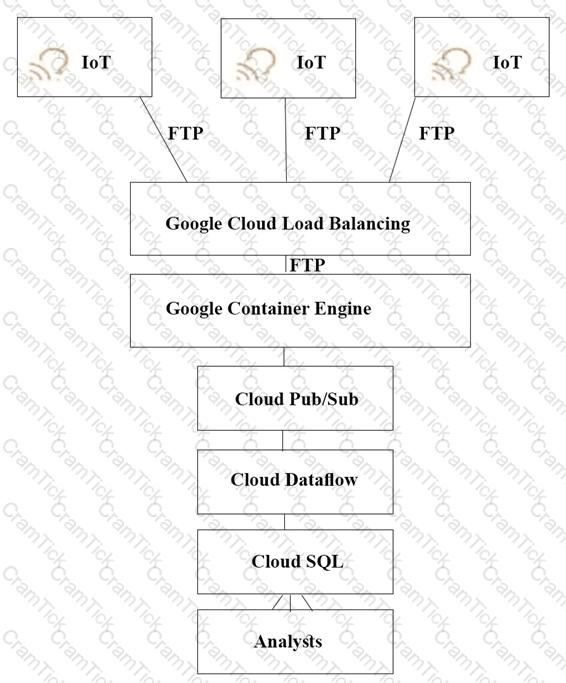
D)
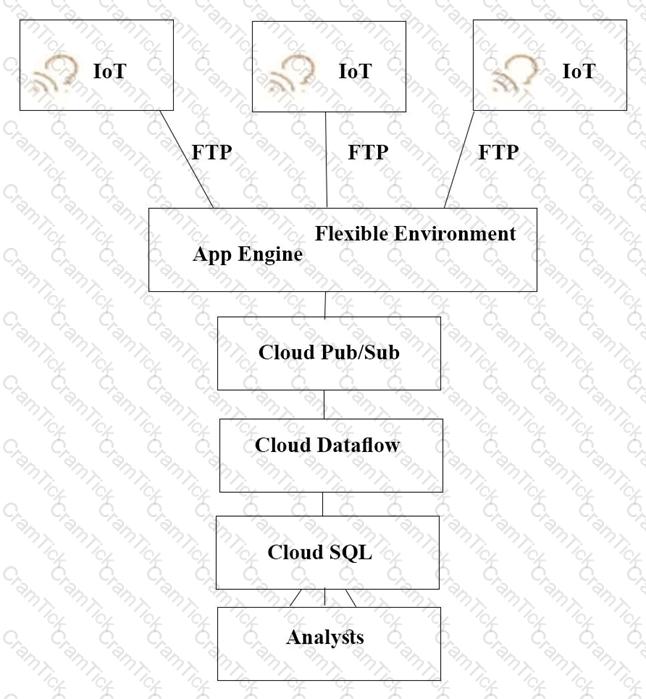
For this question, refer to the EHR Healthcare case study. You need to define the technical architecture for securely deploying workloads to Google Cloud. You also need to ensure that only verified containers are deployed using Google Cloud services. What should you do? (Choose two.)
For this question, refer to the EHR Healthcare case study. In the past, configuration errors put public IP addresses on backend servers that should not have been accessible from the Internet. You need to ensure that no one can put external IP addresses on backend Compute Engine instances and that external IP addresses can only be configured on frontend Compute Engine instances. What should you do?
For this question, refer to the JencoMart case study.
The migration of JencoMart’s application to Google Cloud Platform (GCP) is progressing too slowly. The infrastructure is shown in the diagram. You want to maximize throughput. What are three potential bottlenecks? (Choose 3 answers.)
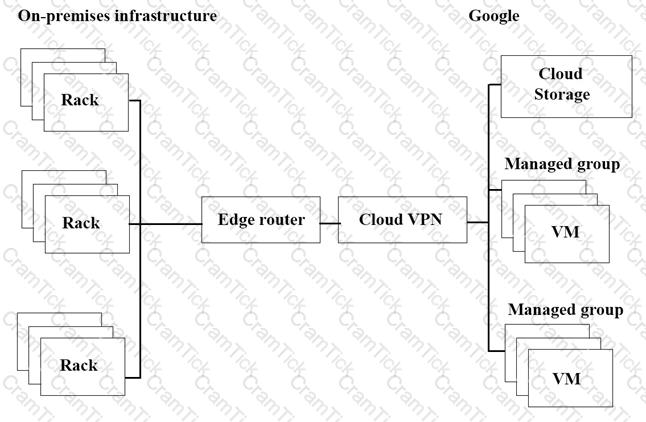
For this question, refer to the JencoMart case study
A few days after JencoMart migrates the user credentials database to Google Cloud Platform and shuts down the old server, the new database server stops responding to SSH connections. It is still serving database requests to the application servers correctly. What three steps should you take to diagnose the problem? Choose 3 answers
For this question, refer to the JencoMart case study.
JencoMart wants to move their User Profiles database to Google Cloud Platform. Which Google Database should they use?
For this question, refer to the JencoMart case study.
JencoMart has decided to migrate user profile storage to Google Cloud Datastore and the application servers to Google Compute Engine (GCE). During the migration, the existing infrastructure will need access to Datastore to upload the data. What service account key-management strategy should you recommend?
For this question, refer to the JencoMart case study.
JencoMart has built a version of their application on Google Cloud Platform that serves traffic to Asia. You want to measure success against their business and technical goals. Which metrics should you track?
You are creating a solution to remove backup files older than 90 days from your backup Cloud Storage bucket. You want to optimize ongoing Cloud Storage spend. What should you do?
Your company is designing its application landscape on Compute Engine. Whenever a zonal outage occurs, the application should be restored in another zone as quickly as possible with the latest application data. You need to design the solution to meet this requirement. What should you do?
You want to store critical business information in Cloud Storage buckets. The information is regularly changed but previous versions need to be referenced on a regular basis. You want to ensure that there is a record of all changes to any information in these buckets. You want to ensure that accidental edits or deletions can be easily roiled back. Which feature should you enable?
Your company is running a stateless application on a Compute Engine instance. The application is used
heavily during regular business hours and lightly outside of business hours. Users are reporting that the
application is slow during peak hours. You need to optimize the application’s performance. What should you do?
For this question, refer to the JencoMart case study.
The JencoMart security team requires that all Google Cloud Platform infrastructure is deployed using a least privilege model with separation of duties for administration between production and development resources. What Google domain and project structure should you recommend?
All compute Engine instances in your VPC should be able to connect to an Active Directory server on specific ports. Any other traffic emerging from your instances is not allowed. You want to enforce this using VPC firewall rules.
How should you configure the firewall rules?
You are implementing the infrastructure for a web service on Google Cloud. The web service needs to receive and store the data from 500,000 requests per second. The data will be queried later in real time, based on exact matches of a known set of attributes. There will be periods where the web service will not receive any requests. The business wants to keep costs low. Which web service platform and database should you use for the application?
You have a Python web application with many dependencies that requires 0.1 CPU cores and 128 MB of memory to operate in production. You want to monitor and maximize machine utilization. You also to reliably deploy new versions of the application. Which set of steps should you take?
You need to deploy an application on Google Cloud that must run on a Debian Linux environment. The application requires extensive configuration in order to operate correctly. You want to ensure that you can install Debian distribution updates with minimal manual intervention whenever they become available. What should you do?
Your company is planning to perform a lift and shift migration of their Linux RHEL 6.5+ virtual machines. The virtual machines are running in an on-premises VMware environment. You want to migrate them to Compute Engine following Google-recommended practices. What should you do?
For this question, refer to the Dress4Win case study.
At Dress4Win, an operations engineer wants to create a tow-cost solution to remotely archive copies of database backup files. The database files are compressed tar files stored in their current data center. How should he proceed?
The current Dress4win system architecture has high latency to some customers because it is located in one
data center.
As of a future evaluation and optimizing for performance in the cloud, Dresss4win wants to distribute it's system
architecture to multiple locations when Google cloud platform.
Which approach should they use?
Dress4win has end to end tests covering 100% of their endpoints.
They want to ensure that the move of cloud does not introduce any new bugs.
Which additional testing methods should the developers employ to prevent an outage?
For this question, refer to the Dress4Win case study.
Dress4Win would like to become familiar with deploying applications to the cloud by successfully deploying some applications quickly, as is. They have asked for your recommendation. What should you advise?
For this question, refer to the Dress4Win case study.
You want to ensure Dress4Win's sales and tax records remain available for infrequent viewing by auditors for at least 10 years. Cost optimization is your top priority. Which cloud services should you choose?
For this question, refer to the Dress4Win case study.
Dress4Win has asked you to recommend machine types they should deploy their application servers to. How should you proceed?
For this question, refer to the Dress4Win case study.
As part of their new application experience, Dress4Wm allows customers to upload images of themselves. The customer has exclusive control over who may view these images. Customers should be able to upload images with minimal latency and also be shown their images quickly on the main application page when they log in. Which configuration should Dress4Win use?
For this question, refer to the Dress4Win case study.
Dress4Win has asked you for advice on how to migrate their on-premises MySQL deployment to the cloud. They want to minimize downtime and performance impact to their on-premises solution during the migration. Which approach should you recommend?
You are implementing Firestore for Mountkirk Games. Mountkirk Games wants to give a new game
programmatic access to a legacy game's Firestore database. Access should be as restricted as possible. What
should you do?
For this question, refer to the Mountkirk Games case study.
Mountkirk Games wants you to design their new testing strategy. How should the test coverage differ from their existing backends on the other platforms?
For this question, refer to the Dress4Win case study.
The Dress4Win security team has disabled external SSH access into production virtual machines (VMs) on Google Cloud Platform (GCP). The operations team needs to remotely manage the VMs, build and push Docker containers, and manage Google Cloud Storage objects. What can they do?
For this question, refer to the Mountkirk Games case study. You need to analyze and define the technical architecture for the compute workloads for your company, Mountkirk Games. Considering the Mountkirk Games business and technical requirements, what should you do?
For this question, refer to the TerramEarth case study
You analyzed TerramEarth's business requirement to reduce downtime, and found that they can achieve a majority of time saving by reducing customers' wait time for parts You decided to focus on reduction of the 3 weeks aggregate reporting time Which modifications to the company's processes should you recommend?
For this question, refer to the Mountkirk Games case study.
Mountkirk Games has deployed their new backend on Google Cloud Platform (GCP). You want to create a thorough testing process for new versions of the backend before they are released to the public. You want the testing environment to scale in an economical way. How should you design the process?
For this question, refer to the Mountkirk Games case study.
Mountkirk Games' gaming servers are not automatically scaling properly. Last month, they rolled out a new feature, which suddenly became very popular. A record number of users are trying to use the service, but many of them are getting 503 errors and very slow response times. What should they investigate first?
For this question, refer to the Mountkirk Games case study
Mountkirk Games needs to create a repeatable and configurable mechanism for deploying isolated application environments. Developers and testers can access each other's environments and resources, but they cannot access staging or production resources. The staging environment needs access to some services from production.
What should you do to isolate development environments from staging and production?
For this question, refer to the Mountkirk Games case study.
Mountkirk Games wants to set up a continuous delivery pipeline. Their architecture includes many small services that they want to be able to update and roll back quickly. Mountkirk Games has the following requirements:
• Services are deployed redundantly across multiple regions in the US and Europe.
• Only frontend services are exposed on the public internet.
• They can provide a single frontend IP for their fleet of services.
• Deployment artifacts are immutable.
Which set of products should they use?
For this question, refer to the Mountkirk Games case study.
Mountkirk Games wants to set up a real-time analytics platform for their new game. The new platform must meet their technical requirements. Which combination of Google technologies will meet all of their requirements?
For this question, refer to the TerramEarth case study.
To speed up data retrieval, more vehicles will be upgraded to cellular connections and be able to transmit data to the ETL process. The current FTP process is error-prone and restarts the data transfer from the start of the file when connections fail, which happens often. You want to improve the reliability of the solution and minimize data transfer time on the cellular connections. What should you do?
Your agricultural division is experimenting with fully autonomous vehicles.
You want your architecture to promote strong security during vehicle operation.
Which two architecture should you consider?
Choose 2 answers:
For this question, refer to the TerramEarth case study
Your development team has created a structured API to retrieve vehicle data. They want to allow third parties to develop tools for dealerships that use this vehicle event data. You want to support delegated authorization against this data. What should you do?
For this question, refer to the TerramEarth case study.
TerramEarth plans to connect all 20 million vehicles in the field to the cloud. This increases the volume to 20 million 600 byte records a second for 40 TB an hour. How should you design the data ingestion?
For this question, refer to the TerramEarth case study.
TerramEarth has equipped unconnected trucks with servers and sensors to collet telemetry data. Next year they want to use the data to train machine learning models. They want to store this data in the cloud while reducing costs. What should they do?
For this question, refer to the TerramEarth case study.
TerramEarth's 20 million vehicles are scattered around the world. Based on the vehicle's location its telemetry data is stored in a Google Cloud Storage (GCS) regional bucket (US. Europe, or Asia). The CTO has asked you to run a report on the raw telemetry data to determine why vehicles are breaking down after 100 K miles. You want to run this job on all the data. What is the most cost-effective way to run this job?
For this question, refer to the Dress4Win case study. You want to ensure that your on-premises architecture meets business requirements before you migrate your solution.
What change in the on-premises architecture should you make?
For this question, refer to the Dress4Win case study. You are responsible for the security of data stored in
Cloud Storage for your company, Dress4Win. You have already created a set of Google Groups and assigned the appropriate users to those groups. You should use Google best practices and implement the simplest design to meet the requirements.
Considering Dress4Win’s business and technical requirements, what should you do?
For this question, refer to the Dress4Win case study. Which of the compute services should be migrated as –is and would still be an optimized architecture for performance in the cloud?
For this question, refer to the Dress4Win case study. Dress4Win is expected to grow to 10 times its size in 1 year with a corresponding growth in data and traffic that mirrors the existing patterns of usage. The CIO has set the target of migrating production infrastructure to the cloud within the next 6 months. How will you configure the solution to scale for this growth without making major application changes and still maximize the ROI?
For this question, refer to the Dress4Win case study. To be legally compliant during an audit, Dress4Win must be able to give insights in all administrative actions that modify the configuration or metadata of resources on Google Cloud.
What should you do?
For this question, refer to the Dress4Win case study. Considering the given business requirements, how would you automate the deployment of web and transactional data layers?
For this question, refer to the TerramEarth case study. TerramEarth has decided to store data files in Cloud Storage. You need to configure Cloud Storage lifecycle rule to store 1 year of data and minimize file storage cost.
Which two actions should you take?
TerramEarth has about 1 petabyte (PB) of vehicle testing data in a private data center. You want to move the data to Cloud Storage for your machine learning team. Currently, a 1-Gbps interconnect link is available for you. The machine learning team wants to start using the data in a month. What should you do?
For this question, refer to the TerramEarth case study.
You start to build a new application that uses a few Cloud Functions for the backend. One use case requires a Cloud Function func_display to invoke another Cloud Function func_query. You want func_query only to accept invocations from func_display. You also want to follow Google's recommended best practices. What should you do?
For this question, refer to the Helicopter Racing League (HRL) case study. Recently HRL started a new regional
racing league in Cape Town, South Africa. In an effort to give customers in Cape Town a better user
experience, HRL has partnered with the Content Delivery Network provider, Fastly. HRL needs to allow traffic
coming from all of the Fastly IP address ranges into their Virtual Private Cloud network (VPC network). You are
a member of the HRL security team and you need to configure the update that will allow only the Fastly IP
address ranges through the External HTTP(S) load balancer. Which command should you use?
For this question, refer to the Helicopter Racing League (HRL) case study. HRL wants better prediction
accuracy from their ML prediction models. They want you to use Google’s AI Platform so HRL can understand
and interpret the predictions. What should you do?
For this question, refer to the Helicopter Racing League (HRL) case study. The HRL development team
releases a new version of their predictive capability application every Tuesday evening at 3 a.m. UTC to a
repository. The security team at HRL has developed an in-house penetration test Cloud Function called Airwolf.
The security team wants to run Airwolf against the predictive capability application as soon as it is released
every Tuesday. You need to set up Airwolf to run at the recurring weekly cadence. What should you do?
For this question, refer to the Helicopter Racing League (HRL) case study. A recent finance audit of cloud
infrastructure noted an exceptionally high number of Compute Engine instances are allocated to do video
encoding and transcoding. You suspect that these Virtual Machines are zombie machines that were not deleted
after their workloads completed. You need to quickly get a list of which VM instances are idle. What should you
do?
For this question, refer to the Helicopter Racing League (HRL) case study. HRL is looking for a cost-effective
approach for storing their race data such as telemetry. They want to keep all historical records, train models
using only the previous season's data, and plan for data growth in terms of volume and information collected.
You need to propose a data solution. Considering HRL business requirements and the goals expressed by
CEO S. Hawke, what should you do?
For this question, refer to the Helicopter Racing League (HRL) case study. Your team is in charge of creating a
payment card data vault for card numbers used to bill tens of thousands of viewers, merchandise consumers,
and season ticket holders. You need to implement a custom card tokenization service that meets the following
requirements:
• It must provide low latency at minimal cost.
• It must be able to identify duplicate credit cards and must not store plaintext card numbers.
• It should support annual key rotation.
Which storage approach should you adopt for your tokenization service?
Google Cloud Certified | Professional-Cloud-Architect Questions Answers | Professional-Cloud-Architect Test Prep | Google Cloud Certified - Professional Cloud Architect exam Questions PDF | Professional-Cloud-Architect Online Exam | Professional-Cloud-Architect Practice Test | Professional-Cloud-Architect PDF | Professional-Cloud-Architect Test Questions | Professional-Cloud-Architect Study Material | Professional-Cloud-Architect Exam Preparation | Professional-Cloud-Architect Valid Dumps | Professional-Cloud-Architect Real Questions | Google Cloud Certified Professional-Cloud-Architect Exam Questions


